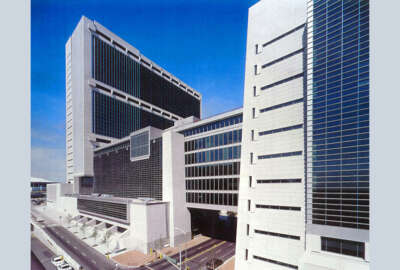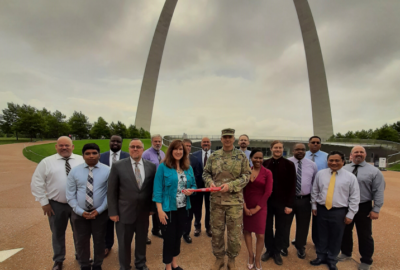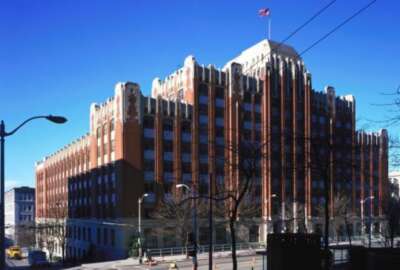The 85 percent: FEBs’ future is open-ended, but not uncertain
With a new structure, a strategic plan and more consistent funding, Federal Executive Boards (FEBs) appear ready to greet the future federal workforce.
From Feb. 12-16, Federal News Network will, day by day, dive into the details of each of the four Federal Executive Board regions currently operating across the U.S. On top of featuring the work and plans of each of the boards, we’ll take a closer look at the path that lies ahead for FEBs. Stay tuned for more!
After operating more or less steadily for the last six decades, Federal Executive Boards (FEBs) across the country are on the verge of a transformation.
Even though FEBs have been in operation since 1961, inconsistent funding and a lack of structure have hindered their ability to scale up support of the nationwide federal workforce.
But with the FEB program now housed under the Office of Personnel Management, Deputy Associate Director for FEBs Kelly DeGraff is hoping to change that.
“The centralized oversight makes us more accountable and transparent, which really then improves our overall responsiveness to both government agencies and to the public,” DeGraff said in an exclusive interview.
Federal Executive Boards already have a clear set of goals: Help federal employees make decisions about their health benefits and retirement; organize charity events and support the Combined Federal Campaign; make local office closure announcements; coordinate disaster response efforts; offer various training and career development opportunities; and highlight the exceptional work of local federal employees through awards programs.
But after OPM became the overseer of FEBs, the agency created a new initiative, called “FEB forward,” to try to take the program up another notch. The initiative, paired with a new strategic plan for FEBs, relies on three main pillars:
- Building a cohesive organization with inclusive governance
- Ensuring excellence in operational impact
- Elevating the profile of FEBs
The possibility of change for FEBs also comes from now more consistent funding. In the past, FEBs relied only on voluntary funding from regional agencies. But now that agencies have authorization to contribute more funding in support of the FEB program, more options are opening up.
“Where the rubber meets the road”
Many Federal Executive Boards’ leaders across the country see their programs as providing a “hands-on” approach to understanding the problems of the federal workforce. For Zuleika Morales-Romero, co-chairwoman of The Alamo FEB in San Antonio, Texas, it’s about policy in D.C., versus action in the field.
“The field is all about where the rubber meets the road,” Morales-Romero said. “We don’t primarily deal in theory down here — we are federal programs in action.”
Even now with a largely hybrid work model in government, it can still be difficult for FEB leaders to elevate the voices of feds thousands of miles away, and bring their input and ideas back to D.C. — even though that is, in essence, the purpose of the FEB program.
“Sometimes information doesn’t flow down as fast to those outside of D.C.,” Christal Murray, the Los Angeles FEB’s former executive director, said. “And sometimes, our voices or input does not seem to be carried back to decision-makers in D.C.”
But headquarters officials in the nation’s capital are trying to turn that around. Leaders at the General Services Administration and the Office of Management and Budget — both of which still play a role in managing the FEB program — said they view FEBs’ insights as critical to the decisions they make back in D.C.
“Federal Executive Boards provide valuable insights from agency leaders all over the country that are closest to the communities we serve,” GSA Deputy Administrator Katy Kale said in a statement. “For GSA, these ground-level insights are particularly important when it comes to federal space and acquisition decisions to help make government work better.”
“FEBs are uniquely situated to serve as the front door of the federal government in American communities,” added Loren DeJonge Schulman, OMB’s associate director for performance and personnel management. “FEBs are critical in building relationships with key regional stakeholders, including state and local governments, colleges and universities, civic institutions, and community organizations, that can help advance key federal priorities and help serve the American people.”
And soon, even more federal voices may be coming into the picture. As part of the FEB forward initiative, OPM plans to connect more federal employees across the country. The expansion of the FEB program could mean a lot of different things. There’s a possibility of adding more FEBs in different cities, or expanding the reach of existing ones.
FEBs’ future is not prescriptive
Before solidifying the expansion plan, OPM is trying to learn as much as it can directly from the source: the senior leaders who currently manage the 28 different FEBs’ locations nationwide.
For months, OPM’s DeGraff has been traveling around the country to meet firsthand with local FEB leaders and senior executives in government. DeGraff, along with other OPM officials, are gathering input from local FEB leadership to try to make the most informed decisions possible about how to improve FEBs’ impact for the foreseeable future.
In some areas, expansion of the FEBs’ reach is already underway. The FEBs in South Florida and Detroit, Michigan, for instance, are already looking to spread out geographically.
“2024 will be a transitional year for our FEB as we increase our territory from South Florida to covering all of Florida,” Agnes Winokur, the South Florida FEB’s vice chairwoman, told Federal News Network.
“In the past, we have been very oriented toward serving the metropolitan Detroit area, but we will now be looking to extend our reach to the four corners of our state,” Michael Polsinelli, chairman of the Detroit FEB, added.
DeGraff said she thinks of the FEB forward initiative as a “realignment” of the program. But how exactly FEBs will change in the future depends on what works well in practice, and then pivoting the plan based on what doesn’t work.
“We don’t have a prescriptive roadmap,” DeGraff said. “In 2024 and 2025, we’re going to pilot various ways of what this can look like. And when we pilot, we have to not be afraid to fail — not all pilots work. I believe that there is a very positive element that can come from ‘failing forward.’ So, we’re going to see what happens, and we’re going to see how we can fill these gaps. There will be some trial and error there, but I think that the opportunities are really exciting to uncover.”
Especially now with OPM taking the reins, FEBs might see a larger focus on the workforce aspect of FEBs. And DeGraff said that’s becoming all the more important as agencies press for more diverse talent and compete against the private sector.
“We are starting to work on strategies of what an FEB strategic initiative could look like to really do targeted recruitment and increase our partnerships with different academic institutions, community colleges, universities and trade schools,” DeGraff said. “How do we formalize some of these partnerships and really create that pipeline to help reduce some of that uncertainty in what the next legacy of the public service workforce looks like?”
Copyright © 2025 Federal News Network. All rights reserved. This website is not intended for users located within the European Economic Area.
Drew Friedman is a workforce, pay and benefits reporter for Federal News Network.
Follow @dfriedmanWFED







